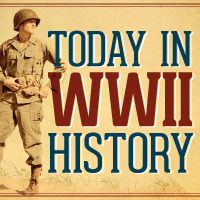Sarah Sundin's Blog, page 435
April 2, 2013
Today in World War II History
 70 Years Ago—Apr. 2, 1943: War Production Board approves construction of “Little Big Inch” pipeline to take refined oil from Texas to northeast states.
70 Years Ago—Apr. 2, 1943: War Production Board approves construction of “Little Big Inch” pipeline to take refined oil from Texas to northeast states.
Published on April 02, 2013 01:00
April 1, 2013
Make It Do - Meat and Cheese Rationing in World War II
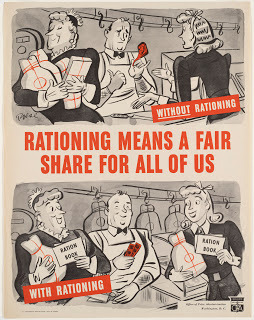 Rationing of meat and cheese was an important part of life on the US Home Front. A complex and constantly changing system kept grocery shoppers on their toes.
Rationing of meat and cheese was an important part of life on the US Home Front. A complex and constantly changing system kept grocery shoppers on their toes.Why meat and cheese?
The United States produced meat and cheese for her civilians and military, and also for her Allies. During World War I, food shortages were a serious problem, with hoarding, escalating prices, and rushes on stores. When World War II started, the government reduced deliveries to stores and restaurants, instituted price controls, and urged people to voluntarily reduce consumption. Britain had already instituted a point-based rationing system and had found it effective, so the United States decided to implement a similar program in 1943. Rationing made sure everyone got a fair share.
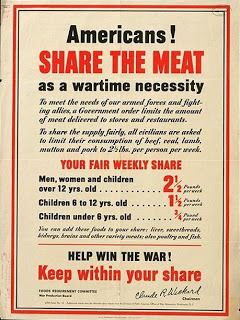 What was rationed?
What was rationed?On March 29, 1943, meats and cheeses were added to rationing. Rationed meats included beef, pork, veal, lamb, and tinned meats and fish. Poultry, eggs, fresh milk—and Spam—were not rationed. Cheese rationing started with hard cheeses, since they were more easily shipped overseas. However, on June 2, 1943, rationing was expanded to cream and cottage cheeses, and to canned evaporated and condensed milk.
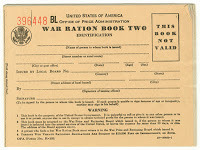 Ration Books
Ration BooksWar Ration Books Two, Three, and Four contained blue stamps for processed foods, and red stamps for meat, cheese, and fats. Each person received 64 red stamps each month to provide 2 pounds of meat and 4 ounces of cheese per week. The stamps were printed with a number for point value and a letter to specify the rationing period—such as B8. Rationing calendars printed in newspapers notified people of which stamps were current and for how long. To prevent fraud, the stamps had to be torn off in the presence of the grocer. Stamps were good for eight, five, two, or one points each, with no “change” given, so the shopper had to be careful to use the exact number of stamps. The system was simplified on February 27, 1944, when plastic tokens were issued as change.
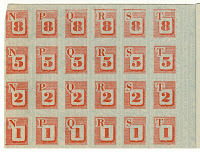 Points
PointsEach cut of meat had a point value assigned per pound, based not on price or quality, but on scarcity. These point values varied throughout the war depending on supply and demand. “Variety meats” such as kidney, liver, brain, and tongue had little use for the military, so their point values were low. On May 3, 1944, thanks to a good supply, all meats except steak and choice cuts of beef were removed from rationing—temporarily.
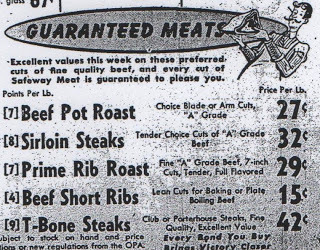 Safeway Ad in Antioch Ledger, July 1943Shortages
Safeway Ad in Antioch Ledger, July 1943ShortagesAs the Allies advanced, newly liberated countries required food that their war-ravaged lands couldn’t produce. The United States stepped forward to meet those needs, but shortages resulted on the Home Front. For Thanksgiving in 1944, the supply of turkeys was short, and on December 31, 1944, all meats were returned to rationing. Even with tightened rationing, a serious meat shortage developed in the spring and summer of 1945. San Diego reported a 55 percent decrease in the supply of meat, and in San Francisco, only lamb and sausage were available. For the first time, even chicken and eggs were in short supply. Things improved after the victory parades, and on November 23, 1945 meat and cheese rationing came to an end.
Making Do
Throughout the war, American housewives learned to make do with less meat. Chicken and rabbit hutches sprang up in backyards, and people were encouraged to fish. Patriotic citizens observed “meatless Tuesdays” and cut meatless recipes out of newspapers and magazines. Soups, stews, and casseroles helped stretch the meat ration, and housewives learned to adapt recipes to organ meats and poultry.
How would you like to deal with meat and cheese rationing?
Published on April 01, 2013 02:00
Today in World War II History
Published on April 01, 2013 01:00
March 31, 2013
Today in World War II History
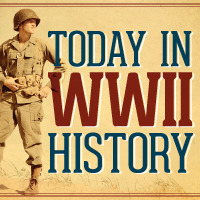 70 Years Ago—Mar. 31, 1943: Oklahoma opens on Broadway, the first musical by Rodgers and Hammerstein.
70 Years Ago—Mar. 31, 1943: Oklahoma opens on Broadway, the first musical by Rodgers and Hammerstein.
Published on March 31, 2013 01:00
March 30, 2013
Today in World War II History
Published on March 30, 2013 01:00
March 29, 2013
Today in World War II History
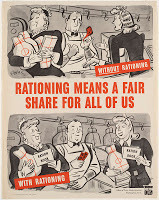 70 Years Ago—Mar. 29, 1943: In US, fresh meat (28 oz/wk), butter, cheese (4 oz/wk) are now rationed.
70 Years Ago—Mar. 29, 1943: In US, fresh meat (28 oz/wk), butter, cheese (4 oz/wk) are now rationed.
Published on March 29, 2013 01:00
March 28, 2013
Book Beat - Love in the Balance by Regina Jennings
 In
Love in the Balance
by Regina Jennings, pretty Molly Lovelace finds herself in a quandary. Molly was raised by her wealthy parents to attract an even wealthier husband, but the only man who turns her head is penniless cowboy Bailey Garner. When dashing Edward Pierrepont arrives in her small Texas town - everything the Lovelaces want for their daughter - Molly doesn't know which way is up. A moment of recklessness, a rash decision, and Molly's life is completely out of balance. Can she decide what she really wants from life - and is it to late to achieve it?
In
Love in the Balance
by Regina Jennings, pretty Molly Lovelace finds herself in a quandary. Molly was raised by her wealthy parents to attract an even wealthier husband, but the only man who turns her head is penniless cowboy Bailey Garner. When dashing Edward Pierrepont arrives in her small Texas town - everything the Lovelaces want for their daughter - Molly doesn't know which way is up. A moment of recklessness, a rash decision, and Molly's life is completely out of balance. Can she decide what she really wants from life - and is it to late to achieve it?The stories I like best show characters learning from their mistakes and growing, and that's exactly what happens in Love in the Balance. Molly starts off self-centered and becomes a woman more concerned with others than with herself. Molly faces the consequences of her actions, not just in her own life but in the lives of others, and learns from them. Regina Jennings's delightful writing, unexpected plot twists, and intriguing characters drew me in. I highly recommend this novel.
Bonus review! My seventeen-year-old daughter grabbed the book before I could, devoured it, and raved about it.
Published on March 28, 2013 22:59
Today in World War II History
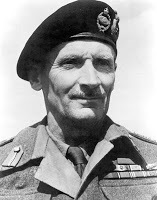 Gen. Bernard Montgomery70 Years Ago—Mar. 28, 1943: Montgomery’s British Eighth Army takes Mareth, Tunisia and 7000 German POWs.
Gen. Bernard Montgomery70 Years Ago—Mar. 28, 1943: Montgomery’s British Eighth Army takes Mareth, Tunisia and 7000 German POWs.
Published on March 28, 2013 01:00
March 27, 2013
Today in World War II History
 70 Years Ago—Mar. 27, 1943: Germans delay British/New Zealanders at Tebaga Gap and retreat to Wadi Akarit, Tunisia. US defeats Japanese in naval battle of Komondorski Islands in Aleutians, the longest continuous gun battle in history of US Navy.
70 Years Ago—Mar. 27, 1943: Germans delay British/New Zealanders at Tebaga Gap and retreat to Wadi Akarit, Tunisia. US defeats Japanese in naval battle of Komondorski Islands in Aleutians, the longest continuous gun battle in history of US Navy.
Published on March 27, 2013 01:00
March 26, 2013
Today in World War II History
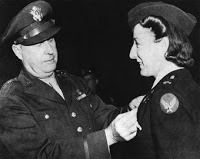 Lt. Elsie Ott receiving Air Medal70 Years Ago—Mar. 26, 1943: Battle of Komandorski Islands begins: US ships intercept Japanese ships trying to resupply Kiska in Aleutians. US War Food Administration established to oversee food production and distribution. Flight nurse Lt. Elsie Ott becomes first woman to earn Air Medal, for 10,000-mile flight from India to DC.
Lt. Elsie Ott receiving Air Medal70 Years Ago—Mar. 26, 1943: Battle of Komandorski Islands begins: US ships intercept Japanese ships trying to resupply Kiska in Aleutians. US War Food Administration established to oversee food production and distribution. Flight nurse Lt. Elsie Ott becomes first woman to earn Air Medal, for 10,000-mile flight from India to DC.
Published on March 26, 2013 01:00

